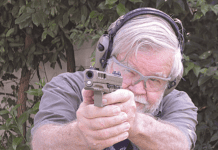Re “Firing Line,” February 2011
I look forward to reading your magazine cover-to-cover. Over the years I have learned a lot, not just about the guns but also about choices of ammunition and potential hazards in both gun and ammunition choices. That is why I paid particular attention to Ray Ordorica’s response to a Firing Line on feeding 308 Win ammo into an M14 variant. I can’t argue with the statements that 7.62 is the right ammo for the M14 and that it should not be used with standard 308 ammo. However, Ray went further than that and stated: “…it ought not be a gas-driven semiauto such as the M14 variants.” The “such as” led me to think in terms of other “gas-driven semiautos.”
Specifically, I have a FN SCAR-17s that I thought was designed to use both (even though it is basically a military weapon designed for the 7.62). Granted it is not an M14 variant, but it is gas-driven, and your response started me sweating and sent me back to the manual and FN website. FN specifically calls out both the 7.62 and 308 in their literature and manuals. That let me breathe a lot easier since I have fed a lot of 308 through it. Could you be a little more specific as to which of the “such as” 7.62 NATO-designed weapons cannot use the 308?
—Tom Ochs
Albany, Oregon
I am not qualified to comment universally on your most interesting question about the proper ammo to use in any given semiauto rifle. There are experts out there such as Clint McKee at Fulton Armory who build and understand rifles such as the M14 and M1, and are thus best qualified to recommend ammo. Various other gun-manufacturing plants across the country surely have their own qualified experts. The maker of each type of rifle (not the importer) is best qualified to comment on the proper ammunition to use in his specific rifle. The best source is the instruction book that comes with each. By the way, the M1A I tested recently does in fact have a chamber marked “308,” with no mention of NATO.
Generally, there are differences between commercial 308 and military 7.62 chamber dimensions. Basically, the military rifle can have a longer chamber and still be considered okay. The headspace gauges for mil and commercial chambers are not the same, though the ammo dimensions generally are the same size. Also, military brass is designed to be heavier-walled, so there’s more brass available to stretch out in the chamber. Further, commercial ammunition has a higher maximum pressure to which it may be loaded. If you combine higher pressure, thinner brass, and a longer chamber, good luck. Bottom line, I suggest you follow your rifle maker’s specific recommendations. Their chamber might well be set up for commercial ammo, not military spec, even though the rifle looks military.
On the Fulton Armory website, Clint McKee and Walt Kuleck wrote an item entitled, “What’s the Difference between .308 Winchester and 7.62x51mm NATO?” In that item they wrote, “They are not the same. They are the same. They are not the same, ‘cause the .308 Win was released by Winchester several years before the Army standarized the T64E3 as the 7.62MM. You’ll get an endless discussion of pressure specs, endless because SAAMI and the Ordnance Dep’t measured pressure in different, unrelateable ways. However, the chamber drawings are different. They are the same, ‘cause nobody (and Clint’s been looking for many years!) makes 7.62mm ammo that isn’t to the .308 “headspace” dimension spec. So 7.62mm ammo fits nicely into .308 chambers, as a rule. But in some 7.62mm rifles, the chambers are long (to the 7.62mm military spec), notably the Navy Garands with 7.62mm barrels.
Thus, using commercial ammo in such a rifle is not a good idea; you need stronger brass. Use military ammo or the best commercial only, e.g., Federal Gold Medal Match. Most of the time it’s a distinction without a difference. But if you intend to shoot .308 commercial in a military arm chambered for 7.62mm, first check the headspace with .308 commercial gauges. You may get a surprise. Walt Kuleck, Fulton Armory webmaster.”
Separately, McKee was asked by a customer, “What’s the difference between .308 Winchester and 7.62x51mm NATO?” His answer: “Jerry Kuhnhausen, in his classic Shop Manual (available from Fulton Armory; see the M1 Rifle Parts and Accessories or M14 Rifle Parts and Accessories Pages under Books) has published a somewhat controversial recommendation concerning .308 Winchester and 7.62x51mm NATO ammo, headspace and chambers. I broached the subject with him some months ago. He had his plate full, so we decided to chat on this in the future. When we do I’ll report the results of our conversation.
“I completely agree with Jerry that if you have a chamber with headspace much in excess of 1.636 (say, 1.638, SAAMI field reject), you must use only U.S. or NATO Mil Spec Ammo (always marked 7.62mm and with a cross enclosed by a circle) since the NATO mil spec calls for a far more “robust” brass case than often found in commercial (read .308 Winchester) cartridges. It is precisely why Lake City brass is so highly sought. Lake City brass is Nato spec and reloadable (most NATO is not reloadable, rather it is Berdan primed). Indeed, cheaper commercial ammo can fail at the 1.638 headspace (e.g., UMC) in an M14/M1 Garand. Many military gas guns (e.g., M14 Rifles and M60 Machine guns) run wildly long headspace by commercial (SAAMI) standards (U.S. Military field reject limit for the M60 and M14 is 1.6455, nearly 16 thousandths beyond commercial (SAAMI) GO, and nearly 8 thousandths beyond commercial (SAAMI) field reject limit!).
“I also agree that 1.631-1.632 is a near perfect headspace for an M14/M1A or M1 Garand chambered in .308 Winchester. But I think that it also near perfect for 7.62mm NATO!
“I have measured many, many types/manufacturers of commercial and NATO ammo via cartridge “headspace” gauges as well as “in rifle” checks. If anything, I have found various Nato ammo to be in much tighter headspace/chamber compliance than commercial ammo. Indeed, sometimes commercial ammo can not be chambered “by hand” in an M14/M1A with, say, 1.631 headspace (bolt will not close completely by gentle hand manipulation on a stripped bolt, although it will close and function when chambered by the force of the rifle’s loading inertia), though I have never seen this with NATO spec ammo. I.e., if anything, NATO ammo seems to hold at the minimum SAAMI cartridge headspace of 1.629-1.630, better than some commercial ammo!
“So, why set a very long 1.636 headspace in an M14/M1A or M1 Garand? It probably is the conflict mentioned above. Military headspace gauges say one thing, SAAMI headspace gauges say something else, as do the spec’s/compliance covering ammo. In a court of law, who will prevail? I think Kuhnhausen gave all those who do this work a safe way out. However, I believe it not in your, or your rifle’s, best interest. Whether you have a NATO chambered barrel (M14/M1 Garand G.I. “.308 Win.”/7.62mm NATO barrels all have NATO chambers), or a .308 Winchester chamber, keep the headspace within SAAMI limits (1.630 GO, 1.634 NO GO, 1.638 FIELD REJECT). This subject is a bit confusing, and for me difficult to explain in a one way conversation! Clint McKee.” Hope these citations help. —Ray Ordorica
Re “Downrange,” February 2011
Hi, Todd. Love your magazine, but in this issue’s editorial, you referred to “banning assault rifles.” I’m sure you’re getting swamped with pleas like this: please don’t do this. You of all people should know to be more careful with words. Maybe “semi-auto assault-rifle look-alikes” or “modern semi-auto sporting rifles” or “modern sporting rifles” or whatever you like, just please not the “A-word.” Its use just makes life so much easier for the anti-freedom, anti-self-defense confiscator vermin. Thanks.
—Phil Erickson,
Seattle, Washington
Man, I like that “anti-self-defense confiscator vermin” phrase. I’m adding it my Todd’s T’ ‘Tudes imaginary T-shirt line. Some other entries include enough Latin (Sic Semper Tyrannis) to land you on a watch list. But, you’re right. The “assault” word was adjacent to other Brady vermin phrases, and I should have added “so-called” or “inaccurately described” or somesuch before the “A-word.” —Todd Woodard
Re “Two Tokarevs: Yugoslav M57 Outshines
Romanian TT-33,” February 2011
On page 16, you report that the 357 Magnum was introduced in the 1950s, which is incorrect. The 357 Magnum was introduced in 1935. The 44 Magnum was introduced in 1955. In a previous issue where you reviewed the Springfield XDM, you reported that the “striker is partially tensioned when a round is chambered, then the trigger pull tensions the striker more before releasing it.” Not true. While indeed this is the way the Glock pistol works, it is not how the Springfield XD or XDM trigger works. When the striker of an XD is cocked, the trigger releases the fully cocked striker. The XD trigger mechanism is SA in design, as it only releases the striker.
—Charley Heckathorn
According to Springfield Armory the XD/XDM pistols are not SAO. But, the amount of work the trigger does in cocking the striker is very small. —Roger Eckstine
I just finished reading your “Two Tokarevs” comparison. It was one of the few I have read completely. Most of the guns you review are either far beyond my near-zero budget or for purposes I do not pursue. I purchased a Romanian TTC from J&G Sales of Arizona. I believe at that time, the price was less than you paid for the Yugoslav M57. They apparantly ran out and now are selling M57s. You appear to have gotten a particularly bad one. Yes, the Romanian safety is a piece of *hit; however, it is in an excellent position for fast draw. My gun has a full-length grip plate on each side. My right grip lacks only the commie star. I have not checked my slide for burrs, but I have not had much trouble removing the barrel. From what I have read, I would give the Yugoslav M57 a “B.” I don’t like magazine safeties. I guess you need the extra round in the magazine if it is the only magazine you will ever see. I think standard 8-round TT33 magazines are still available from Numrich.
—Cliff Runkle,
Carson City, Nevada
Re “1911 Range Showdown: Colt Has Heritage,
but Places Third,” February 2011
Some of your numbers in the showdown are blatantly incorrect. Under Kimber, you show Cor-Bon and Oregon Trail ammo has the same average and smallest group sizes. That’s impossible! For the Colt Gold Cup, using Oregon Trail ammo, you state that the average group size is smaller than the smallest group size. That’s even more impossible. That really hurts your (or your proofreader’s) credibility. Please make sure somebody checks all of the meaningful group size figures.
—Floyd Morgan
I stand corrected, and thanks for reading this article with an eagle eye. You are correct. The averages, according to my notes, are correct, but the smallest group with the Colt is actually 1.3 inches and 1.2 for the Kimber, which is why I preferred the Kimber, although the Colt made a good showing. I may have made a mistake in the mean and average. I work hard to accurately report, but I am glad to see an experienced reader share his knowledge, even when it means I am corrected. In the end, I sold the Colt and kept the Kimber. —R. K. Campbell




















